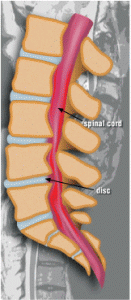By Hector Mayo, PT
Spinal stenosis is a narrowing of the spine that is usually caused by osteoarthritis. Less common causes include a herniated disc, stiffening of the ligaments in the spine, spinal tumors, injuries,  Paget’s disease and dwarfism. While it is possible to be born with spinal stenosis, most cases develop after age 50.
Paget’s disease and dwarfism. While it is possible to be born with spinal stenosis, most cases develop after age 50.
Spinal stenosis is most common in the lumbar spine, in the lower back, and occurs less frequently in the cervical spine, in the neck. It only rarely affects the thoracic spine, in the mid-back. When the narrowing spine puts pressure on the spinal cord or nerves that branch out from it, pain or numbness in the back, legs, neck, shoulders or arms can result. With spinal stenosis that causes leg pain, walking can exacerbate the problem, while sitting or bending forward can decrease the pain. Stenosis in the cervical spine can cause problems with balance and coordination, and patients may develop a tendency to fall.
In rare cases, spinal stenosis can compress the cauda equina, the bundle of nerve roots that extends from the end of the lumbar spine. This compression is called cauda equina syndrome, and it may cause severe low back pain, bladder and bowel dysfunction, sexual dysfunction, weakness in the legs, and an inability to feel the areas of the body that would sit in a saddle. This condition should be treated immediately to avoid permanent incontinence or paralysis.
In many cases of spinal stenosis, anti-inflammatory medications and physical therapy can relieve symptoms. In physical therapy, patients learn specific exercises to increase strength and flexibility in the muscles and ligaments that support the spine. This can improve posture and alleviate symptoms. Regular exercise can also help with losing weight, which often reduces pain. Some patients receive epidural steroid injections to reduce inflammation and relieve pain. Surgery may be recommended for patients with severe symptoms that are not helped by other treatments.